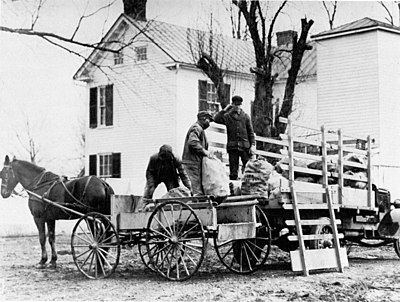
Trucks also played an important role in civilian life by making short haul runs faster and cheaper than could the overburdened trains.
Even greater tonnages, in the aggregate, were hauled by business and industry in company-owned vehicles. In 1917 and 1918, the Goodyear Tire and Rubber Company ran its trucks on schedule from Akron to Chicago and even Boston, carrying relief drivers and running day and night. By the spring of 1918, the White Motor Company of Cleveland was sending most of its new trucks to the East under their own power over the “Liberty Highway,” a route through central New York which the White Company drivers had pioneered to avoid the massive breakups on the Army truck routes. After 1 year of truck deliveries, the Otis Elevator Company found that it had saved $100,000 in the cost of boxing and crating for truck shipments as compared to rail shipment, as well as a great deal of paper work. Where 6 days to 6 weeks had been required for rail delivery, the company trucks needed only 24 hours and delivered the goods in better condition. Because of the shorter delivery time, less capital was tied up in goods in transit.[1]
These and similar experiences by hundreds of other shippers permanently changed the shipping habits of American industry. In a matter of a few months, the railroads lost millions of tons of freight business by default—business they were destined never to recover.
Fresh Vegetables by Mail
The Post Office Department began rural mail delivery by automobile in 1915, and by 1917 a considerable number of the 43,562 rural routes were motorized, but of these, only 288 emanated from the 50 largest cities.[N 1][4]
In July 1916, Congress authorized the Postmaster General to conduct experiments in three or more communities to determine “the most practical means of extending the operations of the parcel post in the direction of promoting the marketing of farm products and furthering direct transactions between producers and consumers.”[5]
By the time the Government established the first experimental routes, war had been declared, and the pinch on railroad cars for short-haul shipments was already being felt. Although the service was not cheap (½ cent per pound for hauls averaging 50
- ↑ The dispatch of rural mail by automobile began July 1, 1915, at Quarryville, Pennsylvania. The vehicles were required to be of at least 80 cubic feet capacity and able to carry 800 pounds of mail.[2] In 1915 carriers serving motor vehicle routes that were at least 50 miles long, 6 days per week, received $1,800 per year. Carriers serving horsedrawn vehicle routes at least 24 miles long received $1,200 per year. All carriers were required to furnish their own transportation.[3]
- ↑ Comparison Of Short-Haul Truck And Rail Shipments, Engineering News-Record, Vol. 82, No. 19, May 8, 1919, pp. 903, 904.
- ↑ Editorial, American Motorist, Vol. 7, No. 4, Jul. 1915, p. 436.
- ↑ Joint Resolution Making Appropriations for the Post Office Department for Fiscal Year 1916 (38 Stat 1227).
- ↑ H. Doc. 159, 65th Cong., 1st Sess., p. 2.
- ↑ 39 Stat 424.
